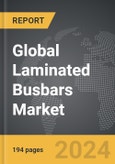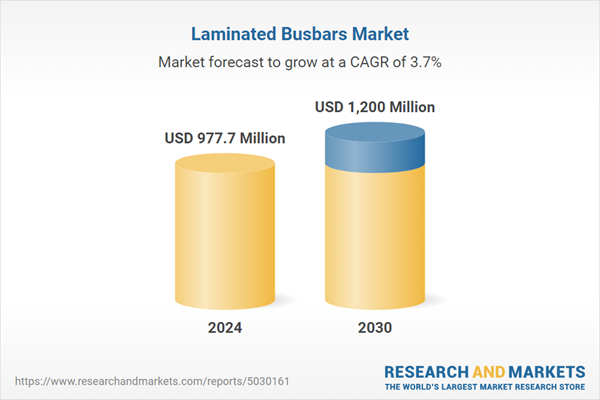Global Laminated Busbars Market - Key Trends & Drivers Summarized
How Are Laminated Busbars Revolutionizing Power Distribution in Modern Industries?
Laminated busbars are revolutionizing power distribution in modern industries by offering a more efficient, reliable, and compact solution compared to traditional wiring methods. These components, consisting of layers of conductive materials separated by insulating layers, are widely used in high-power applications, such as inverters, power converters, and energy storage systems. Laminated busbars significantly reduce inductance and resistance, leading to improved electrical performance and minimized power losses. Their compact design also allows for better space utilization in equipment, which is crucial in industries where space is at a premium. As industries continue to demand higher efficiency and reliability in power distribution, laminated busbars are becoming an essential component in electrical systems across various sectors, including renewable energy, automotive, aerospace, and industrial automation.Why Is There a Growing Demand for Laminated Busbars in Renewable Energy Applications?
The growing demand for laminated busbars in renewable energy applications is driven by the need for efficient and reliable power distribution solutions in solar and wind power installations. As renewable energy projects scale up, the complexity and power requirements of electrical systems increase, making traditional wiring methods less viable. Laminated busbars provide an ideal solution by offering low inductance, high current-carrying capacity, and the ability to handle high voltages, all of which are critical in the efficient transmission of power in renewable energy systems. Additionally, the modular and customizable nature of laminated busbars allows for easy integration into diverse renewable energy setups, enhancing the overall efficiency and reliability of these systems. As the global push towards renewable energy continues to accelerate, the demand for laminated busbars in this sector is expected to grow significantly.What Challenges Are Affecting the Adoption of Laminated Busbars in Various Industries?
Despite their advantages, the adoption of laminated busbars in various industries faces several challenges, including high initial costs, design complexity, and the need for specialized manufacturing processes. The production of laminated busbars involves precise layering and insulation techniques, which can be costlier than traditional wiring methods. This higher cost can be a barrier, especially for smaller companies or industries with tight budget constraints. Additionally, the design of laminated busbars requires careful consideration of factors such as thermal management, electrical performance, and mechanical stability, which can complicate the integration process. The need for custom designs tailored to specific applications also adds to the complexity and cost. To overcome these challenges, manufacturers are focusing on developing cost-effective production techniques, offering modular solutions that simplify integration, and providing comprehensive design support to help industries fully leverage the benefits of laminated busbars.What Factors Are Driving Growth in the Laminated Busbars Market?
The growth in the laminated busbars market is driven by several factors, including the increasing demand for efficient power distribution systems in high-power applications, the expansion of renewable energy projects, and continuous advancements in power electronics. As industries such as electric vehicles, aerospace, and industrial automation require more compact, efficient, and reliable power distribution solutions, laminated busbars are becoming the preferred choice due to their superior performance characteristics. The rapid growth of renewable energy projects, particularly in solar and wind power, is also fueling demand for laminated busbars, as these systems require efficient power transmission components to manage the high currents and voltages involved. Additionally, advancements in power electronics, such as the development of higher efficiency inverters and converters, are creating new opportunities for laminated busbars, as these components are critical in optimizing the performance of such devices. As these trends continue, the laminated busbars market is expected to experience robust growth, driven by the need for advanced power distribution solutions across a wide range of industries.Report Scope
The report analyzes the Laminated Busbars market, presented in terms of units. The analysis covers the key segments and geographic regions outlined below.Segments: Insulation (Epoxy Powder Coating, Polyester Film, PVF Film, Polyester Resin, Heat-Resistant Fiber, Polyimide Film); Conductor (Copper, Aluminum); End-Use (Utilities, Industrial, Commercial, Residential).
Geographic Regions/Countries: World; United States; Canada; Japan; China; Europe (France; Germany; Italy; United Kingdom; Spain; Russia; and Rest of Europe); Asia-Pacific (Australia; India; South Korea; and Rest of Asia-Pacific); Latin America (Argentina; Brazil; Mexico; and Rest of Latin America); Middle East (Iran; Israel; Saudi Arabia; United Arab Emirates; and Rest of Middle East); and Africa.
Key Insights:
- Market Growth: Understand the significant growth trajectory of the Epoxy Powder Coating segment, which is expected to reach US$447.1 Million by 2030 with a CAGR of a 3.1%. The Polyester Film segment is also set to grow at 4.0% CAGR over the analysis period.
- Regional Analysis: Gain insights into the U.S. market, valued at $261.2 Million in 2024, and China, forecasted to grow at an impressive 6.4% CAGR to reach $251.3 Million by 2030. Discover growth trends in other key regions, including Japan, Canada, Germany, and the Asia-Pacific.
Why You Should Buy This Report:
- Detailed Market Analysis: Access a thorough analysis of the Global Laminated Busbars Market, covering all major geographic regions and market segments.
- Competitive Insights: Get an overview of the competitive landscape, including the market presence of major players across different geographies.
- Future Trends and Drivers: Understand the key trends and drivers shaping the future of the Global Laminated Busbars Market.
- Actionable Insights: Benefit from actionable insights that can help you identify new revenue opportunities and make strategic business decisions.
Key Questions Answered:
- How is the Global Laminated Busbars Market expected to evolve by 2030?
- What are the main drivers and restraints affecting the market?
- Which market segments will grow the most over the forecast period?
- How will market shares for different regions and segments change by 2030?
- Who are the leading players in the market, and what are their prospects?
Report Features:
- Comprehensive Market Data: Independent analysis of annual sales and market forecasts in US$ Million from 2024 to 2030.
- In-Depth Regional Analysis: Detailed insights into key markets, including the U.S., China, Japan, Canada, Europe, Asia-Pacific, Latin America, Middle East, and Africa.
- Company Profiles: Coverage of players such as Amphenol Corporation, Electronic Systems Packaging LLC, George Ellison Ltd., Jans Copper Pvt. Ltd., MERSEN South Africa and more.
- Complimentary Updates: Receive free report updates for one year to keep you informed of the latest market developments.
Some of the 41 companies featured in this Laminated Busbars market report include:
- Amphenol Corporation
- Electronic Systems Packaging LLC
- George Ellison Ltd.
- Jans Copper Pvt. Ltd.
- MERSEN South Africa
- Methode Electronics, Inc.
- OEM Automatic Ltd.
- Rogers Corporation
- Ryoden Kasei Co. Ltd.
- Shennan Circuits Company Limited
Tariff Impact Analysis: Key Insights for 2025
Global tariff negotiations across 180+ countries are reshaping supply chains, costs, and competitiveness. This report reflects the latest developments as of April 2025 and incorporates forward-looking insights into the market outlook.The analysts continuously track trade developments worldwide, drawing insights from leading global economists and over 200 industry and policy institutions, including think tanks, trade organizations, and national economic advisory bodies. This intelligence is integrated into forecasting models to provide timely, data-driven analysis of emerging risks and opportunities.
What’s Included in This Edition:
- Tariff-adjusted market forecasts by region and segment
- Analysis of cost and supply chain implications by sourcing and trade exposure
- Strategic insights into geographic shifts
Buyers receive a free July 2025 update with:
- Finalized tariff impacts and new trade agreement effects
- Updated projections reflecting global sourcing and cost shifts
- Expanded country-specific coverage across the industry
Table of Contents
Companies Mentioned (Partial List)
A selection of companies mentioned in this report includes, but is not limited to:
- Amphenol Corporation
- Electronic Systems Packaging LLC
- George Ellison Ltd.
- Jans Copper Pvt. Ltd.
- MERSEN South Africa
- Methode Electronics, Inc.
- OEM Automatic Ltd.
- Rogers Corporation
- Ryoden Kasei Co. Ltd.
- Shennan Circuits Company Limited
Table Information
| Report Attribute | Details |
|---|---|
| No. of Pages | 194 |
| Published | April 2025 |
| Forecast Period | 2024 - 2030 |
| Estimated Market Value ( USD | $ 977.7 Million |
| Forecasted Market Value ( USD | $ 1200 Million |
| Compound Annual Growth Rate | 3.7% |
| Regions Covered | Global |









